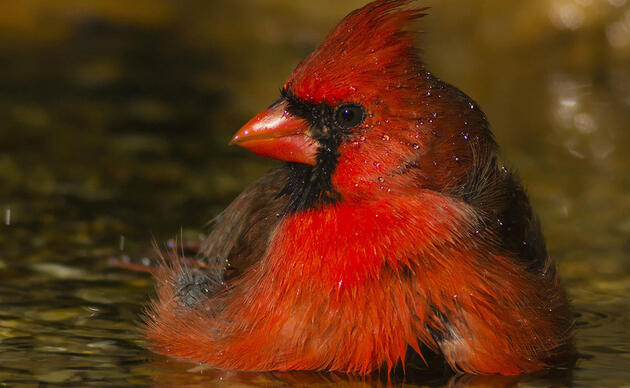
Economic Benefits of Florida Bay at Risk
During the past few years, Florida Bay’s unique habitat and wildlife have been negatively impacted by a lack of freshwater. This also impacts the local community that is so dependent on the bay’s resources as an economic driver. Researchers are estimating that 50,000 acres of the bay were impacted by seagrass die-off during the last two years. This serves as a stark reminder of the sensitivity of the seagrass community to the effects of hyper-saline water caused by lack of adequate freshwater flow to this estuary. At the same time, a recent economic report by the Everglades Foundation shows Florida Bay supports 4,100 jobs and the economic impact of recreational anglers is $430 million annually.
With the loss of seagrass, the bay bottoms do not offer suitable habitat for prey that water birds and game fish depend on. Roseate Spoonbills and other nesting wading birds had a tough time rearing chicks this season. Seasoned bay fishing guides calling this the bleakest state of fishing in their careers.
Despite these worrisome findings, the resiliency of the ecosystem is offering hope for the future. Audubon scientists are noting the first signs of seagrass re-growth in areas that had been wiped bare. Some algal blooms are also beginning to clear.
Increased Flow of Water Between Lake Okeechobee and Florida Bay Must Be Re-Established to Avoid a Repeat of the Ecological Breakdowns Experienced in Recent Years
Restoration of Florida Bay is a top priority for Audubon, and we are actively working with the Keys community to see the completion of water management projects that would deliver more freshwater to the bay. Last week, the Florida Keys Fishing Guides Association sent a letter to policymakers advocating for legislation that would support the purchase of land in the Everglades Agricultural Area (EAA) for a water storage reservoir project. The EAA Reservoir would help Roseate Spoonbills, other water birds, and game fish who are all in decline.
Annual South Florida Wading Bird Report Shows Steep Nesting Decline in the Everglades
The annual South Florida Wading Bird Report showed that 2016 had the lowest wading bird nesting count since 2008. The report, which is compiled by the South Florida Water Management District and includes a section written by Audubon scientists, also noted that there has not been a strong wading bird nesting season in America’s Everglades in more than a decade.
Nesting of wading birds naturally fluctuated in the pre-drained Everglades, with poor nesting years cushioned by above-average nesting years. Despite the fact that 2016 was a very unusual water year with nearly reversed hydrologic cycles, the lack of an above-average nesting year in the past 10 years compounds the need to expedite restoration projects. Speeding up the current schedule will help stem the decline of key indicator species and avoid hitting an irreversible tipping point.
Compared to the 10-year average in the Greater Everglades Ecosystem:
- White Ibis nesting was down 45 percent;
- Wood Stork nesting was down 38 percent;
- Snowy Egret nesting was down 51 percent;
- Little Blue Heron nesting was down 61 percent;
- Tricolored Heron nesting was down 16 percent;
- Great Egret nesting was down 7 percent; and
- Roseate Spoonbill nesting up 20 percent overall but mainly in inland areas.
For more on the Wading Bird Report, read Audubon’s fact sheet and this article in the Miami Herald.
EAA Reservoir Takes Center Stage in Tallahassee
The Everglades Agricultural Area (EAA) Reservoir is at the core of Senate Bill 10 (SB 10), sponsored by Senator Rob Bradley and House Bill 761 (HB 761) sponsored by Representative Thad Altman. The EAA Reservoir is a key project of the Comprehensive Everglades Restoration Plan (CERP) that will diminish harmful Lake Okeechobee discharges to coastal communities by rerouting water south to rehydrate the parched Southern Everglades and Florida Bay. Simply put, the EAA Reservoir will hold and clean water that is currently going to the wrong place at the wrong time while being able to send freshwater south where it’s needed.
SB 10 passed its second legislative committee with amendments, and last week, Audubon asked Sen. Bradley to improve parts of SB 10 that are not related to the EAA Reservoir. These changes would preserve the important restoration focus while reducing other impacts to land conservation. Audubon remains committed to restoring America’s Everglades and getting the EAA Reservoir built.
Next week, SB 10 will head to its final stop in the Senate Appropriations Committee before a full Senate vote. HB 761 has been assigned to committees but has not been scheduled for a hearing. Now, more than ever, legislators need to hear from you! Help Audubon restore America’s Everglades, and tell your legislator to support the EAA Reservoir contained in SB 10 and HB 761.
Have questions on the EAA Reservoir? Check out Audubon’s Q&A.
Stay in Touch!
Show your love of birds today. Subscribe to receive email updates about Audubon's conservation work and hear about opportunities to help birds in your area or nationwide.




